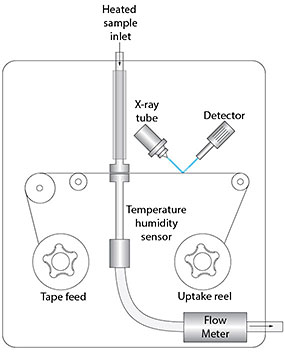Measuring metals (XACT)
The Queensland Government monitors metals continuously in Mount Isa using an XACT ambient metals monitoring instrument.
An XACT instrument was also used to monitor metals in Townsville between September 2015 and July 2021. Since July 2021, Port of Townsville Limited has been monitoring metals at two locations in Townsville – Coastguard and Lennon Drive.
How it works
The diagram below shows how the XACT instrument operates.


A pump draws an air sample into the instrument at 16.7 litres per minute (L/min) through an inlet designed to allow only particles of the required size range pass through.
The sample is then heated above the dew point by the inlet tube heater.
Next, the sample is drawn through a filter tape, which collects particle-phase metals, for a pre-determined sampling interval (e.g. 1 hour). The filter tape is kept on two reels: one that holds the new tape (tape feed) and one that collects the used tape (uptake reel).
As the air sample passes through the filter tape, the temperature, relative humidity and flow are measured.
The filter tape and deposited matter moves forward to a position where it is analysed for metal content using X-Ray Fluorescence (XRF) technology.
In the XRF system, the X-ray tube directs high energy X-rays onto the deposited matter collected on the filter tape which in turn re-emits X-rays with energies characteristic of the atoms present in the sample. These emissions are detected and converted to metal concentrations present in the air sample.
Once a sample has moved to the XRF analysis zone, a new sampling and analysis cycle starts. This provides continuous ambient metal concentrations for pre-determined intervals (e.g. 1 hour).
The advantages of continuous monitoring of metals
Unlike traditional methods for monitoring metals, an XACT instrument provides continuous real-time metals concentration data.
Traditional methods of monitoring heavy metals involve collecting particle samples using high volume samplers and subsequent laboratory analysis of the collected samples.
Due to the labour-intensive nature of these methods, routine monitoring programs have typically collected only one 24-hour sample every six days.
Metals monitoring using an XACT instrument means that additional information, such as the time of day of peak metal concentrations, are available. Used in conjunction with meteorological data, this helps identify sources of metal emissions.
More information
View the live air data service to check the current levels of metals in the monitoring network.


